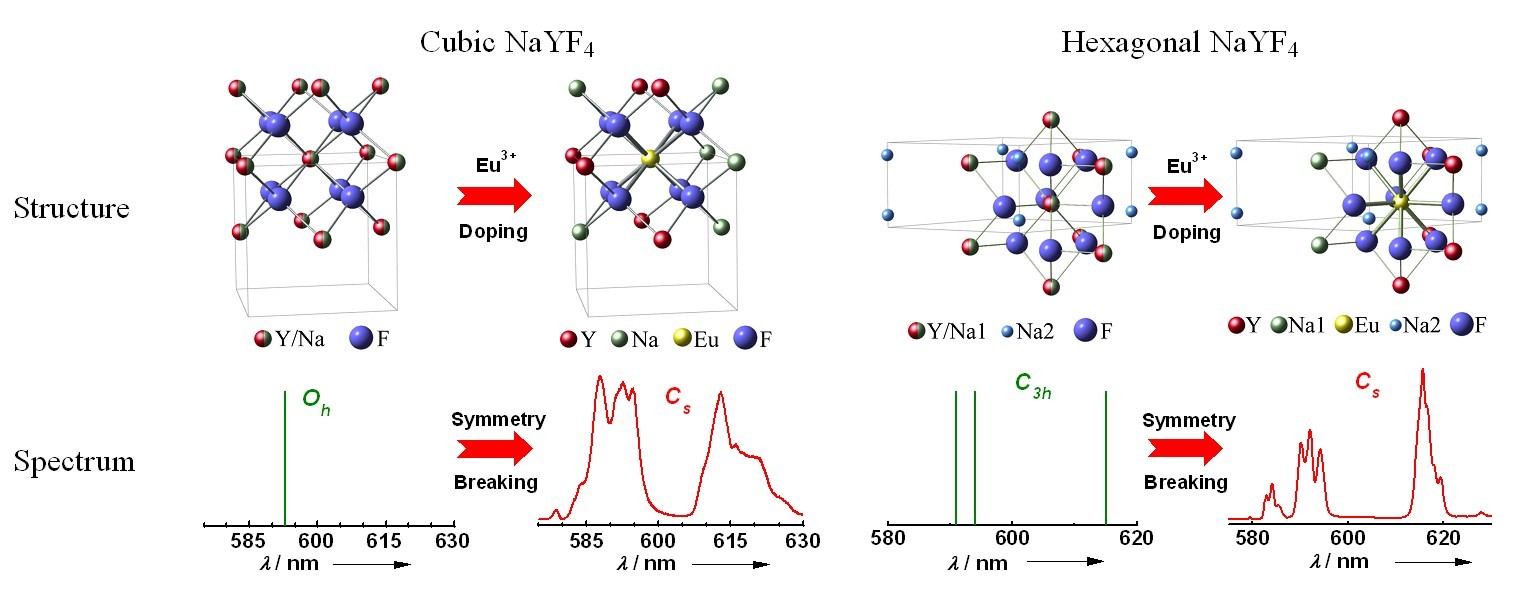Trivalent lanthanide ions (Ln3+) doped disordered inorganic crystals, emerging as a new and huge family of luminescence and laser systems, have attracted reviving interest for their promising applications in laser materials, lighting, flat-panel display and nano-biolabels, owing to their superior optical properties.
However, the exact site symmetry of Ln3+ dopants in the disordered crystals has received much debate for decades, since the optical behavior of Ln3+ does not obey the crystallographic site symmetry determined from single-crystal XRD. The optical transitions of Ln3+ are sensitive to their local coordination, and the emission intensity of Ln3+-based compounds strongly depends on the crystal structure and crystal-field surroundings around Ln3+.
Therefore, Ln3+ ions (i.e., Eu3+) are often used as probe to analyze the local structure of cations in luminescent materials. An unambiguous spectroscopic revelation of local site symmetry breakdown in disordered crystals is extremely important for both fundamental and practical applications.
The research group headed by Prof. CHEN Xueyuan at Fujian Institute of Research on the Structure of Matter(FJIRSM), Chinese Academy of Sciences, has revealed the universal breakdown of crystallographic site symmetry in Ln3+-doped disordered crystals by employing high-resolution photoluminescence spectroscopy that utilizes Eu3+ as the structural probe.
Particularly, they have found that, the spectroscopic site symmetries of Eu3+ descend from crystallographic Oh to Cs (or C2) in cubic (α) NaYF4, and from crystallographic C3h to Cs in hexagonal (β) NaYF4, respectively, which are strongly supported by the crystal-field level fitting deviation from the experiments. These findings about the universal breakdown of crystallographic site symmetry in Ln3+-doped disordered crystals have solved the long debate in this field and paved the way for designing highly luminescent materials. Results of this study have been published in Angew. Chem. Int. Ed. (DOI: 10.1002/anie.201208218).

Schematic illustration showing the breakdown of crystallographic site symmetry of Eu3+ in cubic and hexagonal NaYF4 disordered crystals.( Image by Prof. CHEN Xueyuan’s group)
Previously, Prof. CHEN's group had made a series of progress on the controlled synthesis, optical physics, and bioapplication of Ln3+-doped luminescent materials. They reported the homogeneous time-resolved fluorescence resonance energy transfer (TR-FRET) detection of avidin by employing Ln3+-doped NaYF4 and KGdF4 nanoparticles as bioprobes (Angew. Chem. Int. Ed.,2011, 50, 6306; J. Am. Chem. Soc.,2012, 134, 1323), and also developed a new inorganic oxide bioprobe based on sub-5 nm tetragonal ZrO2:Ln3+ nanoparticles that could be used for sensitive detection of avidin and targeted imaging of human lung cancer cell (J. Am. Chem. Soc.,2012 134, 15083).Besides, Prof. CHEN’s group recently published an invited Feature Article in Nanoscale about the Ln3+-doped luminescent nano-bioprobes, which was highlighted as Front Cover (Nanoscale,DOI: 10.1039/C2NR33239F).
Contact:
Prof. CHEN Xueyuan
Fujian Institute of Research on the Structure of Matter
Chinese Academy of Sciences
Email: xchen@fjirsm.ac.cn